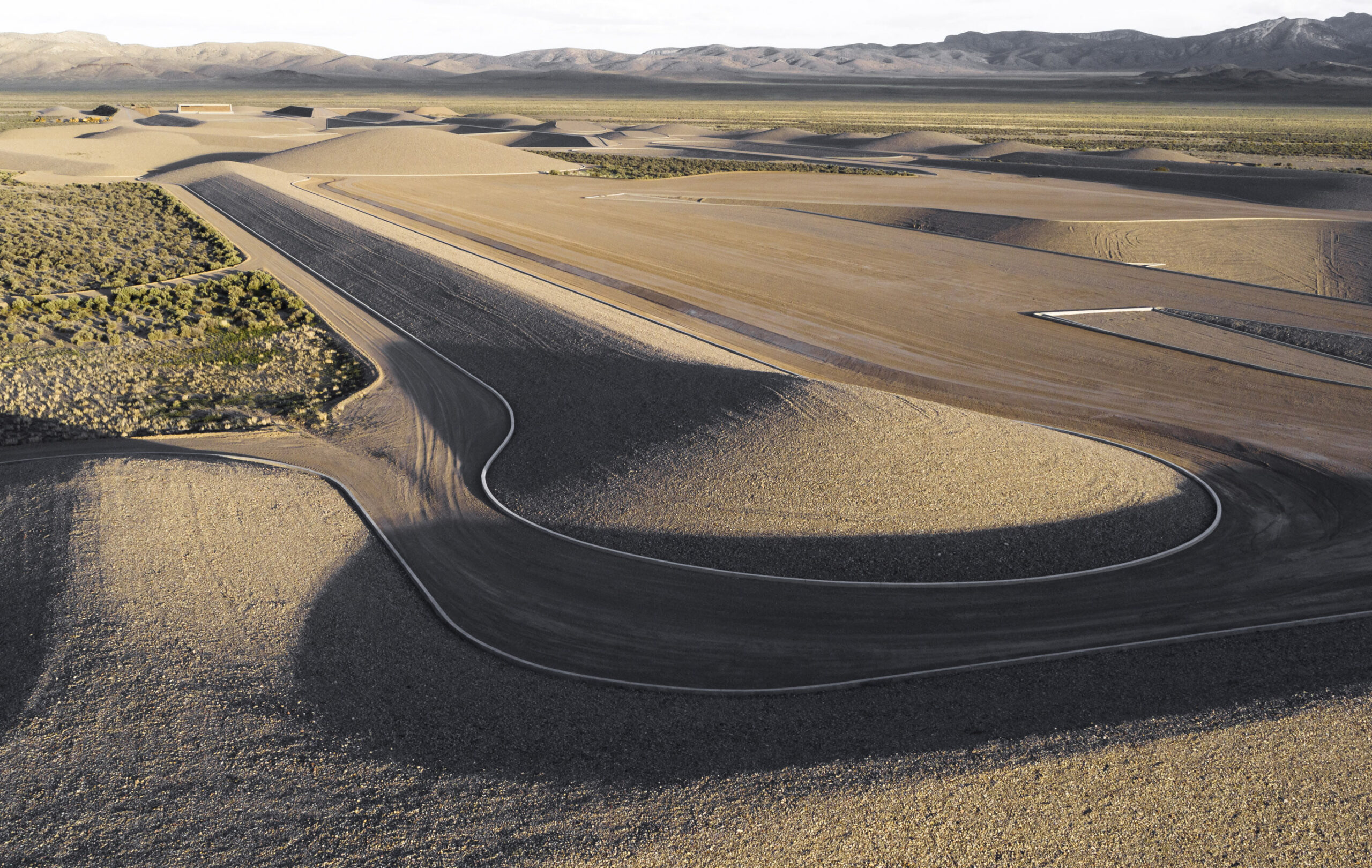In the long afternoon of last year’s summer solstice, Ernest Edwin Higbee Jr. pulled a white Chevrolet Tahoe off the main road of Alamo, Nevada, driving past spindly creosote bush and stalky Nevada ephedra and onto the lonely highway where the Mojave Desert meets the Great Basin.
“People live out here because you are pretty much on your own,” Higbee, who is 70 and goes by Ed, told his six passengers. “And where we’re going, you’ll really know we’re on our own.”
The destination — still more than an hour away — was City, a mile-and-a-half long, half-mile-wide concrete-and-rock sculpture. The artist, Michael Heizer, opened his magnum opus to visitors in September 2022 after more than 50 years of construction.
Heizer, who is self-taught, was one of the first 20th century American artists to imprint the earth and call it art. His work helped define the land art movement of the 1960s and ’70s. Although land art is found all over the world, it’s most often associated with the Western U.S., in works such as Spiral Jetty in the Great Salt Lake and The Lighting Field in New Mexico.
According to Hikmet Loe, an art historian who has studied land art for nearly three decades, the movement arose from the radically changing social and cultural constructs of the 1960s and the art world’s minimalism and conceptual styles. It freed art from rigid galleries and released it into the unruly outdoors.
Most of these 20th century artists, who were generally white and from the East Coast, Loe explained, viewed deserts in the West as a vast nothingness, waiting to be made useful and important.
“There’s this misconception then of blank space we can do what we want to,” Loe said. “That’s left over from Manifest Destiny, from those ideas that it was literally a God-given right.”
When construction of City began in 1970, few Americans had a problem with building a monument in the middle of Nevada. But 50 years later, City opened into a different world, one in which a greater understanding of Indigenous genocide and colonialism’s ongoing impacts stoked criticism of the work’s sociopolitical context and questions about its own message concerning the land.
To Alicia Harris, a Native art history professor at the University of Oklahoma and a member of the Fort Peck Assiniboine and Sioux tribes, these conversations about art and its impact on land echo those Indigenous people have had for centuries.
“My definition of land art is a little bit more expansive in thinking about the ways that people make place and make relationships with the land directly,” Harris said. “We’ve been doing that for a much longer time than the sort of few decades that the ‘land artists’ were doing that.”
Four-thousand-year-old petroglyphs survive less than 30 miles from City. Native tribes in southern Ohio created what’s commonly called “Serpent Mound,” a 1,348-foot-long, 3-foot-high mound in the shape of a snake with a curled tail. These works straddle the blurry line between art and cultural expression, which Harris called an inherited paradigm of Native land art. She pointed to the Assiniboine Tribe’s Sun Dance, a dayslong religious ceremony that includes building lodges, as an example of cultural expression that is “artful” but not designed to be consumed by outsiders as “art.”
At the same time Western artists began carving the earth in the name of art, the American Indian Movement crystallized centuries-old demands to return unceded land. Indigenous nations organized, arranging a 19-month occupation on Alcatraz Island and satirically offering the federal government glass beads and red cloth worth $24 in exchange for it. The 1972 “Trail of Broken Treaties” march on Washington, D.C., demanded the return of 110 million acres.
“America’s favorite pastime is amnesia,” Harris said. “That’s maybe nowhere more evident than in these land art works, when we’re asked to just presume that there wasn’t anything here.”
But for many contemporary Native artists and art historians, like Harris, place-based art has less to do with the land art movement and more to do with the LandBack one.
Higbee turned off the highway and onto a dirt road that winds tightly around rock formations before entering Garden Valley, the remote valley where Heizer built City. Heizer’s ranch, where he lives part-time, is lined with vibrant cottonwood trees that stand out in the landscape of soft blues, browns and greens. The trees are 50 years old, just like City.
In contrast to the ranch, City was distinguishable from this distance only by its lack of vegetation: a simple gray line with a few pillars poking up.
Heizer has said that he chose the area because land was cheap and available. “I’d have built this thing in New Jersey if it had been possible,” he told New York Times reporter Michael Kimmelman, in 1999. Kimmelman later denied that Heizer thought the land was insignificant. City, he said in 2022, was a “love letter to this part of the world.”
“This land is in my blood,” Heizer told Kimmelman.
Heizer declined to be interviewed. But his wife, Kara Vander Weg, who has managed his work at Gagosian Gallery for almost a decade, said Heizer considers himself a Nevadan. His grandfather moved here in the late 1800s, and Heizer often visited his Nevada family while growing up in Berkeley, California, where his father was an archaeology professor.
Rift One in 1968 was the first of Heizer’s 12 pieces of Nevada land art, part of what he called his “Nine Nevada Depressions,” which were constructed by digging into the floors of dry lake beds. Two years later, he moved to Garden Valley and gave City most of his attention for the next five decades.
Now nearing 80, Heizer appears as a figure in boots, jeans and a cowboy hat. Heizer’s friend Michael Govan, director of the Los Angeles County Museum of Art (LACMA), said his gruff Western persona gives outsiders an incomplete picture of the artist.
On one of Govan’s first visits to City, he noted, Heizer received a special package from New York City — espresso ordered from Balducci, an upscale Italian grocery store on Broadway.
That image fits better with the grand scale and tone of City, which has gained international attention both within and beyond the art world. The sprawling monument, which cost roughly $40 million to build, was funded by donations and Heizer’s own funds and labor. The $1.3 million a year it takes to maintain City comes from the support of several museums, including LACMA and the Museum of Modern Art in New York. Access is limited; six $150 tickets are available three days a week, six months a year. (Admission is free to residents of Lincoln, Nye and White Pine counties as well as to Nevada students and educators.) Visitors must arrive in Alamo at a specific time to be driven to City. No photos are allowed.
At least some of these restrictions are meant to protect the experience of the piece, which depends on seclusion for a large part of its allure. Thousands applied when visitor requests first opened; slots for the 2024 season were filled within the first month submissions were accepted.
Alex Bybee, one of the six passengers in Higbee’s Tahoe, first learned about City from the Sunday New York Times when the artwork opened in 2022. He was surprised that an art story — especially one involving Nevada — was on the front page. Rural Nevada rarely receives that kind of attention.
“Part of the experience and journey is coming to a rural part of Nevada,” said Bybee, a Las Vegan who owns a strategy and advocacy consulting firm. “City is this internationally known and recognized piece of art, and people travel to Alamo, Nevada, to see this incredible feat.”
Out-of-state visitors fly into Las Vegas, a town known for entertainment, not art. Then they set off on a two-hour drive that numbs their minds with mile after mile of sagebrush and desert dust, while mountains keep watch from an indecipherable 10 or 100 miles away. The only break in the desert is Alamo, population 1,019, elevation 3,450 feet and “the social and business center of the rich Pahranagat Valley.” From there, visitors are driven by Higbee or his cousin to one of the largest pieces of art in the world.
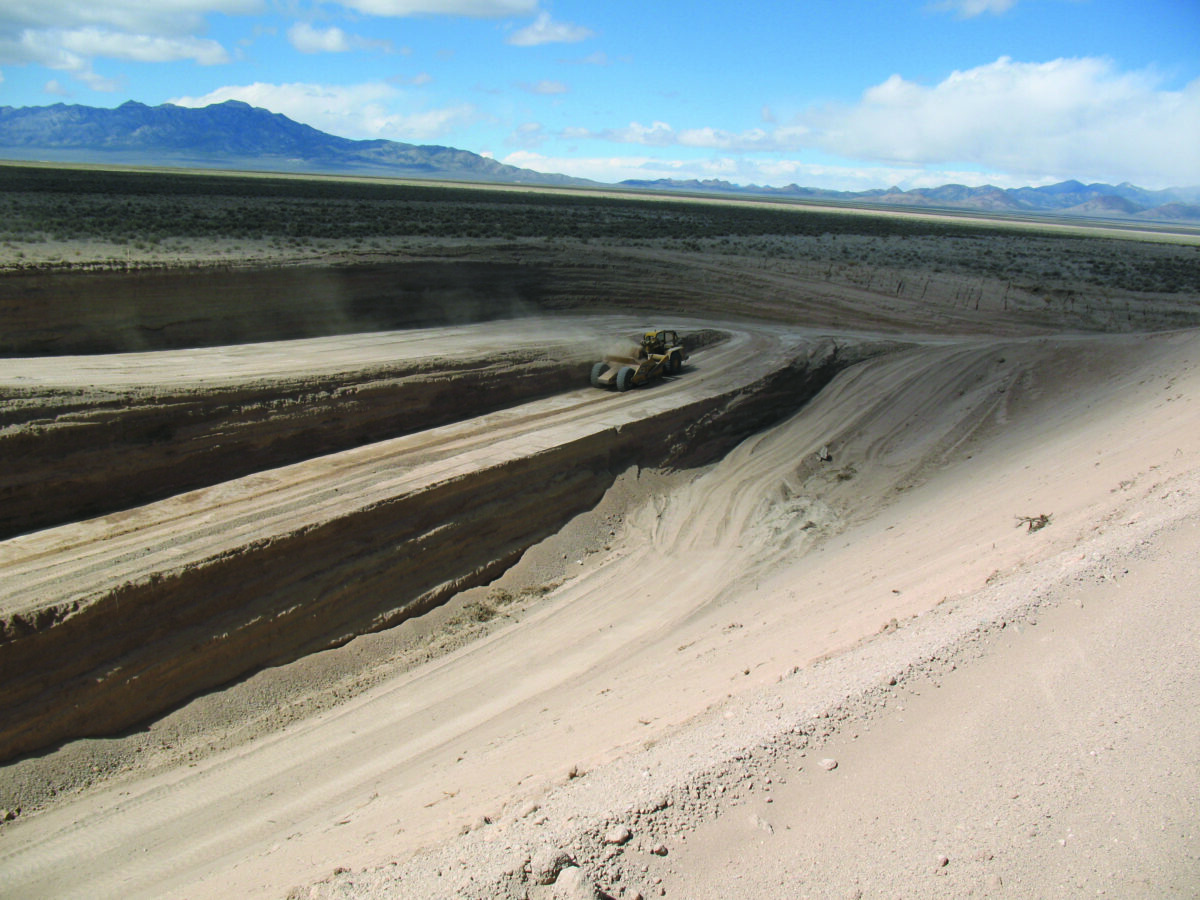
Back on the road, Higbee and his visitors entered Garden Valley. They passed over two cattle guards, and City came into clearer view. It looked like a ridge in the vast flat landscape. The objects sticking out of the ground were slightly more prominent. There was some kind of structure at either end of the ridge — rocks, a visitor might think if they didn’t know better — and lots of dirt and rounded mounds.
Higbee stopped the car to open a rusted metal gate with a “No Trespassing” sign. The group had now entered Heizer’s private island in a 704,000-acre ocean of federal land — the Basin and Range National Monument.
City was key to the monument’s creation in 2015, much to the ire of Heizer’s ranching neighbors. Years earlier, Heizer and Govan connected with the late Sen. Harry Reid (D-NV), over their shared interest in blocking a proposed railroad that would have carried nuclear waste past City and to Yucca Mountain.
The Yucca Mountain plan was vastly unpopular in Nevada, and failure to stop it would have cost Reid politically. For Heizer and Govan, a noisy railroad would ruin the aesthetic of isolation that City relies on. In 2006, Heizer even threatened to dynamite City if the railroad plan went through. But it didn’t.
City’s value as an artwork helped fortify Reid’s public arguments for preserving the desert. President Barack Obama formally designated the national monument on July 10, 2015. At the ceremony, Reid called City one of “the most important, significant works of art in the last 100 years in America.”
Higbee drove by Heizer’s cottonwoods, their lush green tops — once a speck — now looming over the car, before turning onto another dirt road: the final leg to City.
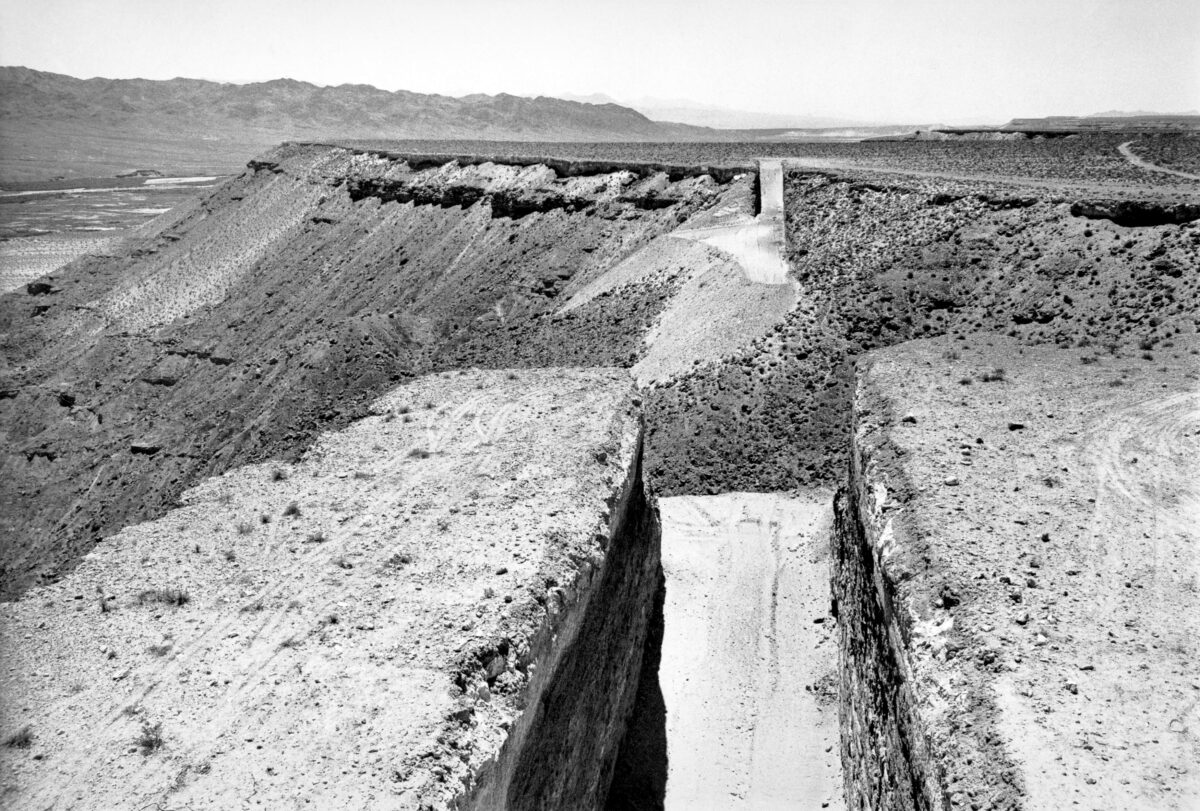
Five years ago, artist Fawn Douglas drove about 70 miles northeast of her home in Las Vegas to see Heizer’s Double Negative sculpture. Heizer made the mirroring 50-foot-deep trenches on Mormon Mesa by blasting 240,000 tons of rock from land that once belonged to Douglas’ Southern Paiute ancestors.
Douglas, an enrolled member of the Las Vegas Paiute Tribe, liked how the earth was reclaiming the land at Double Negative. The once clean-cut walls of the 1969 piece have become more textured as the vegetation has regrown.
But then Douglas remembered how beautiful the land was before Heizer made his mark. She compared the artwork to someone stabbing the earth and leaving a scar.
Like Double Negative, many pieces of land art have started to fade as the land recovers. Rift One, one of Heizer’s nine depressions, is no longer visible. His Circular Surface Planar Displacement Drawing (four circles made from motorcycle tire tracks in Jean Dry Lake) has also vanished.
But City is different. City is meant to last forever. An empire of concrete, City is guarded and maintained and will be indefinitely.
To Douglas, who has not yet seen City, its intended permanence is a message of conquest: Heizer took the land, and it will be his forever. As with other land-art pieces, it’s tainted with destruction, patriarchy, Manifest Destiny and colonialism.
The high desert surrounding City is the ancestral home of the Southern Paiutes and Western Shoshone.
The Southern Paiutes lived nomadically across parts of California, Nevada, Arizona and Utah until Western expansion in the 1800s. The construction of the transcontinental railroad and traders crossing the Old Spanish Trail between California and New Mexico forced Southern Paiutes to settle where they were. The U.S. officially took control of Southern Paiute land when it received Mexico’s territories in 1848 after the Mexican-American War.
Two decades before Heizer’s grandfather came to Nevada, the United States signed a treaty with the Western Shoshone, certifying that the tribe owned its ancestral lands in what is now eastern Nevada while allowing U.S. settlers headed west to pass through. But the U.S. began taking control of the land, piece by piece. In 1962, almost a century after the treaty was signed, the government offered the tribe $26 million in exchange for the land and an end to the tribe’s legal claims against the U.S. In response, the Western Shoshone called for the land to be returned.
In 2021, Fawn Douglas and Rose B. Simpson, an artist from the Santa Clara Pueblo, responded to the land art movement by making Transformance. In the filmed performance, Simpson, Douglas, their daughters and three other Southern Paiute women demonstrated how Indigenous people relate to the land, not by physically marking it but by creating and maintaining a relationship with it.
Amid the bustling traffic of one of Vegas’ busiest thoroughfares, the artists walked to a public park, which the city had closed three years ago for “maintenance and improvement” after unhoused people began congregating there. When the procession reached the park’s edge, Douglas used a knife to cut through the plastic orange fence guarding the area.
As they walked, Douglas said they felt the different textures of the land through their moccasins — dirt, concrete, grass and asphalt. Their handmade regalia acted as a kind of armor as they walked in pairs to protect each other. Douglas said the performance allowed them to slow their heartbeats and create a shared pulse as they showed how they connected to the earth, respecting the land and themselves and taking a stand in their community.
A crowd quietly followed them, unintentionally becoming part of the performance. Their own pensive movements made the piece feel almost ceremonial to Douglas.
“It’s really a metaphor for how people have been following and looking toward Indigenous people and voices to hear how we feel about what is happening to our lands,” Douglas said. ”They’re stopping, pausing and listening and making sure to elevate the Native voices.”
Against the rapidly changing metropolis, the women appeared as “living ghosts,” said Ben-Alex Dupris, the director and editor of Transformance and an enrolled member of the Colville Confederated Tribes in eastern Washington. The women were a reminder that we all live on unceded Indigenous land.
Transformance began and ended at Nuwu Art Gallery and Community Center, just two miles from the 30 acres the Las Vegas Paiute Tribe now owns near downtown. Douglas bought the building a year earlier and has since transformed it into a vibrant community watering hole and the heart of Las Vegas’ Native art scene.
“When we think about land art, we think about the notions of LandBack and what that means for Native peoples,” Douglas said. “So that’s why this space was also chosen, because this is the first Native American-owned gallery space in southern Nevada, and this is our taking back of space. This is our LandBack.”
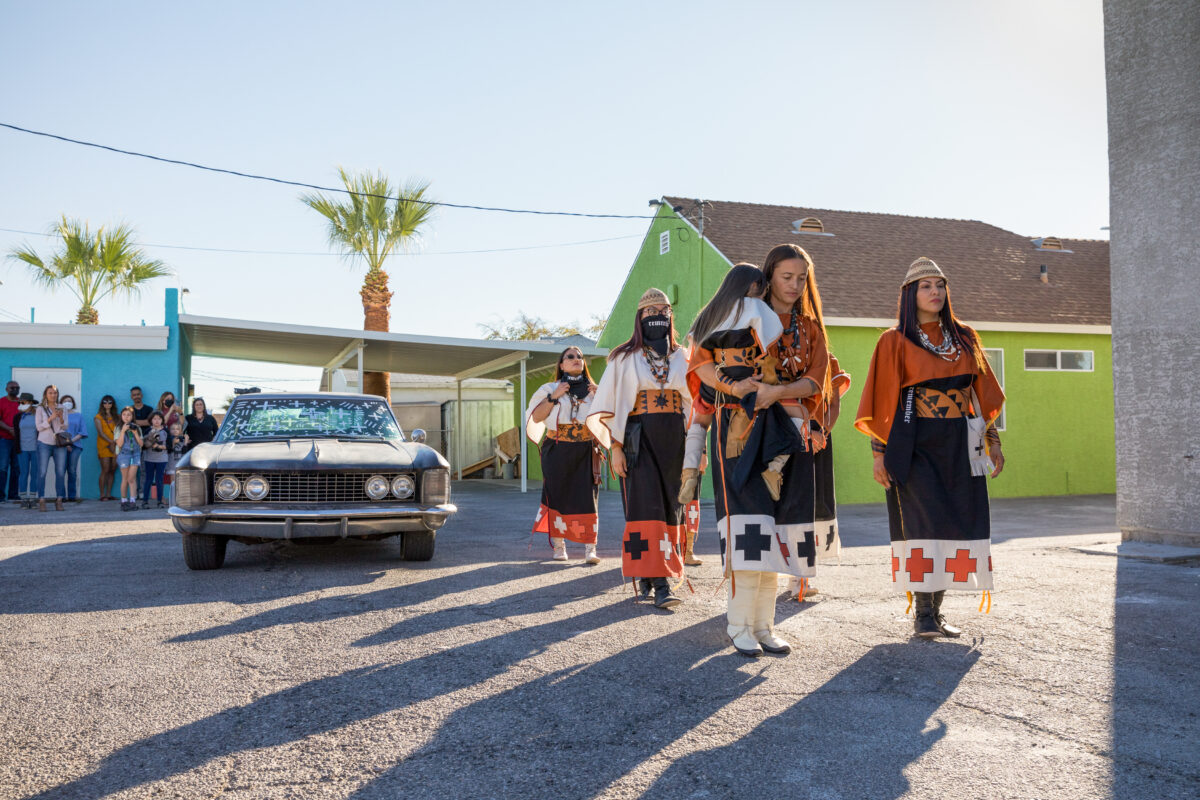
Higbee finally parked the car at the edge of a berm at City’s border.
To the south rose the berm and two towering rock mounds. A dirt path between them led into City. To the north was a sea of sagebrush and desert paintbrush that peppered the area with red. Mountains reigned from the edges of the windblown valley.
The visitors had been discussing the context surrounding City: its part in America’s colonial history, the rights of the people native to the land it sits on, and if any of this would be different if it had been built by someone other than a white man. But once they entered the artwork, the conversation ceased, and the experience took focus.
Standing at City’s central plaza, the visitors saw a deep pit and a hint of cement shapes to the west.
A look to the east revealed one of the rock mounds at the entrance, even larger than it seemed at first. This mound and its sisters in the distance corresponded perfectly with the surrounding rugged mountains. But instead of colliding tectonic plates, Heizer’s mountains were made using attentive human hands and smooth, uniform rocks.
There was only one swatch of color: an oasis of valley flora cradled by clean concrete perimeters between the sculpture’s muted grays and browns — “Central Park,” one visitor called it.
City is a perfection that has to be maintained to prevent innate faults from intruding. Workers regularly pull weeds and drag equipment to smooth dirt paths and remove tracks. The Triple Aught Foundation collaborated with LACMA on a conservation study to plan for the repair and replacement of aging concrete and adjust for new rainfall patterns and flooding from climate change. Vander Weg said a GPS system has recorded exact placements of forms to show whether anything has shifted.
According to Higbee, the Triple Aught Foundation tries to keep the work looking “like you’re the first to ever been here.” He gave the visitors what he calls his “ominous final instructions”: polite reminders of time limits and restroom locations. While the group toured City, Higbee walked around and listened to a true crime podcast.
The six visitors split up. Brent Holmes, a Las Vegas artist, headed east with Scott Dickensheets, a freelance culture writer. Leaving the plaza, they saw only City’s most immediate layers of berms, hills and paths.
Almost immediately, Holmes felt a physical reaction in his stomach.
“One of the important parts of land art to me is how it makes the body move,” Holmes said. “What always fascinates me is how these angles make me stoop and crouch and tilt my head in ways so that I can better understand the structures and the lines and forms that I’m looking at.
“It’s super cool, man,” Holmes said. “I mean, this is fucking rad.”
Dickensheets was struck by the realization that there was no meaning or narrative to the piece; any narrative applied to it would be mangled.
“Math, engineering, formal qualities like line of sight, shadow, all that stuff,” Dickensheets said, “is the toolkit (Heizer’s) using to access the psychological effects and the perceptual effects he wants you to.”
There is solitude but not isolation in City. With six people, you’re rarely so alone you can’t see anyone.
On the way to the anchoring structure at the east end, Dickensheets and Holmes separated. Dickensheets took a path near City’s edge, while Holmes chose the middle route a quarter of a mile away.
“It’s important the way that you can see me, and I can see you!” Holmes yelled, his voice carrying in the quiet.
Dickensheets climbed a path at the top of a steep berm. It looked as if it was made of compacted soil, but the bumpy, airy texture on the sides was closer to a popcorn ceiling. It was actually concrete.
Against this berm and its mirror a half-mile away lay large slabs of concrete that resembled pillars on the drive here. They were crooked and jagged, like pieces of wood tossed aside when a tornado shatters a house. Some rose as high as six feet above Dickensheets’ path and cast slanted shadows on the walkway.
The two berms on City’s margins accentuated the structure between them known as “Complex One.” From City’s central plaza, it resembled a movie screen or a painting. Within a gray frame, there was a tilted brown background and an upside-down black “T.” But something seemed off, like a distorted image your brain couldn’t quite make sense of.
As you got closer, the frame started coming apart. It was actually made of individual, noncontiguous pieces of concrete, and the black lines were shadows from a concrete “T” hovering parallel to the ground. It recalled Heizer’s Levitated Mass, in which two small wedges balance a 340-ton boulder above visitors at LACMA.
Dickensheets, in the shade of Complex One’s trapezoidal backbone, recognized the deceptive structure as a type of optical illusion. Although he considered optical illusions the “lowest form of trickery,” he said, it felt elevated in Heizer’s City.
Holmes sat on a concrete ledge and passed out figs and dried apricots. Most of his own artwork examines himself and his body in the desert. He found many of the sensations of his long hikes in City: the remoteness, the wind whipping past his ears, the sound of his boots crunching rocks beneath him. But visually, City was another planet.
“It’s like he’s taken the outside inside, but it’s still outside. And that’s pretty compelling,” Holmes said. “He’s rendered nature into human confinement in a way that doesn’t feel insulting or like it struggles, which is pretty difficult.”
Asked about the context surrounding City, Holmes said he’s trying to focus on enjoying the piece and temporarily silencing all of the vital conversations around it.
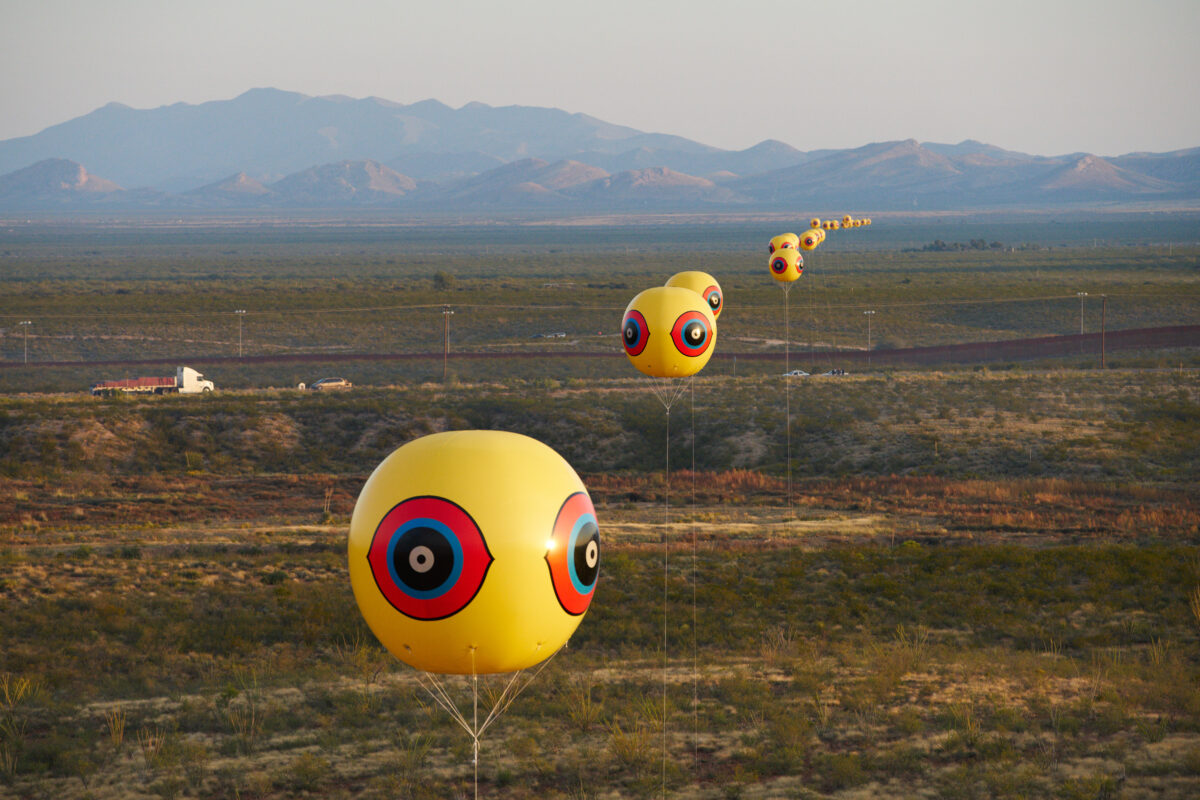
Vander Weg, the Gagosian director and Heizer’s wife, said that the Triple Aught Foundation researched Garden Valley and found that the land was a hunting ground for the Southern Paiutes and Western Shoshone.
City has its own version of the increasingly popular land acknowledgment for the Western Shoshone and Southern Paiutes at the bottom of its website. Douglas calls this “the bare minimum.”
“What is the relationship beyond that?” Douglas said. “How can City actually transform from being just like, ‘Here’s this land art piece,’ to merging with the way Indigenous people approach land art?”
Vander Weg, Govan and the Triple Aught Foundation have defended Heizer against criticism that City disrespects the land or its original inhabitants. They pointed to the solar panels that power his ranch, his long-standing concerns about climate change and how City helped prevent nuclear waste from being transported across the valley. A Triple Aught Foundation spokesperson said City, which is made of materials from its surrounding environment, honors the land through an “intensified experience of place, and the unity of the sculpture with its environment.”
Heizer, for his part, has been mute on these criticisms as well as on City’s inspirations and meanings. He calls it “democratic art, art for the ages.”
“I am not here to tell people what it all means,” he told the Times in 2022. “You can figure it out for yourself.”
In 2005, he defended his silence, explaining that acknowledging his inspirations for City’s designs — the ancient mounds built by Mississippian cultures, for example — did not mean they were copies or that he was “ripping off” those shapes. An earlier comment, where he said he derived some of City’s shapes from Chichén Itzá, the sacred Mayan city in Mexico’s Yucatán Peninsula, has followed him, “as if that’s the whole meaning behind it.” Despite Heizer’s evasions, non-Native journalists often mention the likely influence of Heizer’s trips to ancient earthworks around the globe with his archaeologist father.
For Harris, the Native art history professor, land artists who take inspiration from cultures and people from other lands demonstrate a misunderstanding of their main medium. She described it as a “dispossession of place.”
Harris pointed to Nancy Holt’s concrete Sun Tunnels, which align with the sunrise and sunset of the solstices. Holt included a Navajo poem in a piece she wrote about the tunnels, located nine miles from the Nevada border in northern Utah. But the Navajo never lived there. The Goshute, Western Shoshone and Paiutes did.
In contrast, Harris said, Native land art is invested in the local community.
In Repellent Fence, the art collective Postcommodity created a 2-mile stretch of balloons across the U.S.-Mexican border. The balloons, up for four days in October 2015, were meant to show the connection between the land, its history and the Native communities separated by an abstract divide.
Repellent Fence showcased another distinctive quality of contemporary Native land art: It’s temporary.
For Douglas, art that permanently alters the earth is unethical. In one of her own pieces of land art, she painted and stitched fabric across a 93-foot-long, 1-foot-wide canvas. She then delicately stretched it across desert shrubberies and stones at the University of Nevada, Las Vegas, careful not to damage even an ant hill. When she finished displaying the piece, she rolled the fabric up and left the land as it was. She preserved the experience through photos and videos.
Douglas said that the art was meant to remind people that the land used to belong to the Southern Paiutes. And for a moment, she said, the piece took that land back.
It also showed people — some of who stepped on the art — that it was possible to live on the land without harming it, Douglas said. It showed what land art could be.
“I didn’t make a mark and just destroy this area to where it is not in use, or disturb the insects, the flora, the fauna,” Douglas said. “That’s the difference between the way an Indigenous person like myself would approach land art versus a destructive way.”
Dupris, the Transformance filmmaker, said there are differing opinions on land art across Indigenous cultures.
Dupris, whose father was an enrolled member of the Mnicoujou Lakota Sioux Tribe, pointed to two stories of land art in South Dakota: Mount Rushmore, which he said was often seen as a desecration of the sacred Black Hills, and the Crazy Horse Memorial, a carving of the Lakota leader in those same peaks. It’s a gray area in Native land art, Dupris said, that shows how two similar pieces can have different reactions depending on who’s behind them.
Chief Henry Standing Bear oversaw the creation of the Crazy Horse Memorial, inviting a Polish American sculptor, Korczak Ziolkowski, to carve it starting in 1948, 20 years after construction on Mount Rushmore began. (Times reporter Kimmelman wrote in 2005 that Mount Rushmore was one of the only pieces of American art Heizer “now volunteers to praise.”) Standing Bear argued that the spiritual significance of the Black Hills to the Lakota people made it the appropriate site for the memorial.
For Dupris, the energy directed at land art could be focused on more critical matters, like removing the dams on the Columbia and Snake rivers that damage ecosystems and impede salmon migration. While land art like City can be impressive, Dupris said, it feels “plastic” compared to the natural resources that should be prioritized.
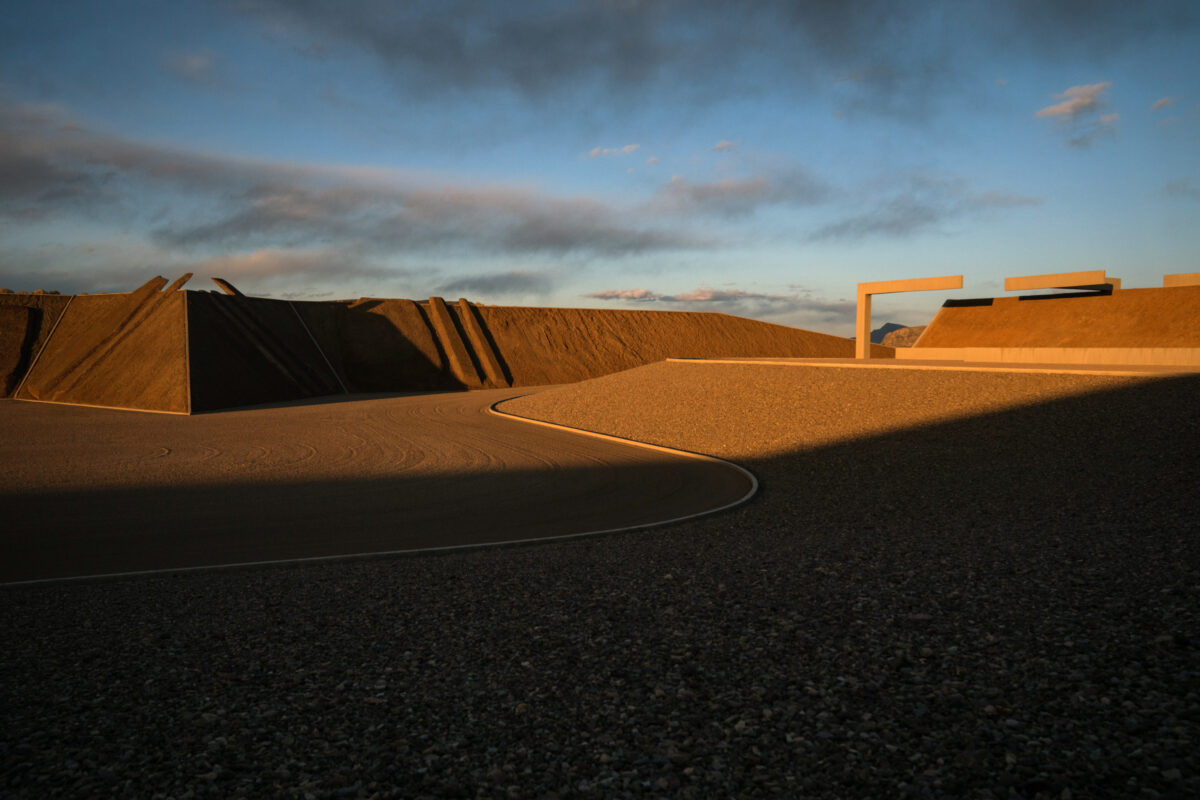
It was a long trudge to the west end of City, where the other main structure sits.
Dickensheets and Holmes separated once more, taking paths of varying altitudes. Without the constant stimulus of cellphones and urban life, the walk forced Dickensheets’ mind to settle and notice City’s details: the subtle shades in the color palette, the spectacularly straight concrete borders, the balance of hills and hollows.
Heizer’s second anchoring structure came into view around the plaza. It looked like a series of pillars in an overall rectangular formation, like the Lincoln Memorial. But as the visitor drew closer to the structure, called 45°, 90°, 180°, it resolved into a series of concrete triangles lined in rows ahead of a rectangular backdrop.
Against the backdrop lay three rectangles. Like scattered children’s blocks, one was tilted against the back wall, another stood parallel and the last lay flat on the ground. While the rest of City reveled in openness, these blocks created the few hiding spots in the monument.
The tall concrete background of 45°, 90°, 180° provided rare shade at City on the cloudless June day, and its concrete floor offered the best place to sit. Benches were a noticeable omission.
Dickensheets and Holmes returned from their respective paths and sat at the base of one of the rectangles. Dickensheets passed trail mix around, and Holmes fumbled some, picking raisins and M&Ms off Heizer’s pristine floor.
It was a humbling human act that felt comforting in a place devoid of humanity. And it was also one of the few hints you had that Heizer’s City was not invincible.
In small moments, evidence of reality appeared within the sterile, alien world Heizer has created.
Sticks had blown onto the berms. The workers had missed some weeds. Birds had made a nest on one of the rectangles of 45°, 90°, 180°.
“Such an interesting choice, all that bird shit,” Dickensheets said.
The solstice washed City in gold for the tour group’s final minutes, warming its cool shades as the visitors met Higbee at the car after the 3-hour encounter. There was a consensus: Everyone wished the time was longer.
City stayed with Dickensheets and Holmes for days afterward. For both, the word that came closest to describing it was sublime.
“There are so many problematic layers to the work, its placement and why it’s there,” said Holmes, who has since been hired at the Triple Aught Foundation. “In the same: Is it bad work? No, City is great for exactly what it is.”
For Harris, City is a monumental example of the national narrative of land in the U.S. The entire country is Indigenous land, and its possession inherently contradicts Indigenous relationships with it. Harris thinks it’s worth questioning City, land art or any other usage of land.
“All of those land artworks were the same,” Harris said. “I would say the same thing about any one of them — that we should be questioning what the actual land itself remembers and what the land itself wants and who belongs to that land everywhere.”
Douglas plans to see City one day. She believes it would help her understand her complex feelings about it. But she’s unsure if she could ever separate the art from its heavy sociopolitical context.
After seeing nature reclaim Double Negative, she thinks about how she would like to reclaim City.
She imagines having a powwow with various tribes across Nevada. They would have campsites across the structure and a southern drum from the powwow circle to create what Douglas called a “moment of reclamation.”
“That would be amazing,” Douglas said. “But at the same time, it would just be a moment. This thing is meant to be something that’s going to be there forever.”
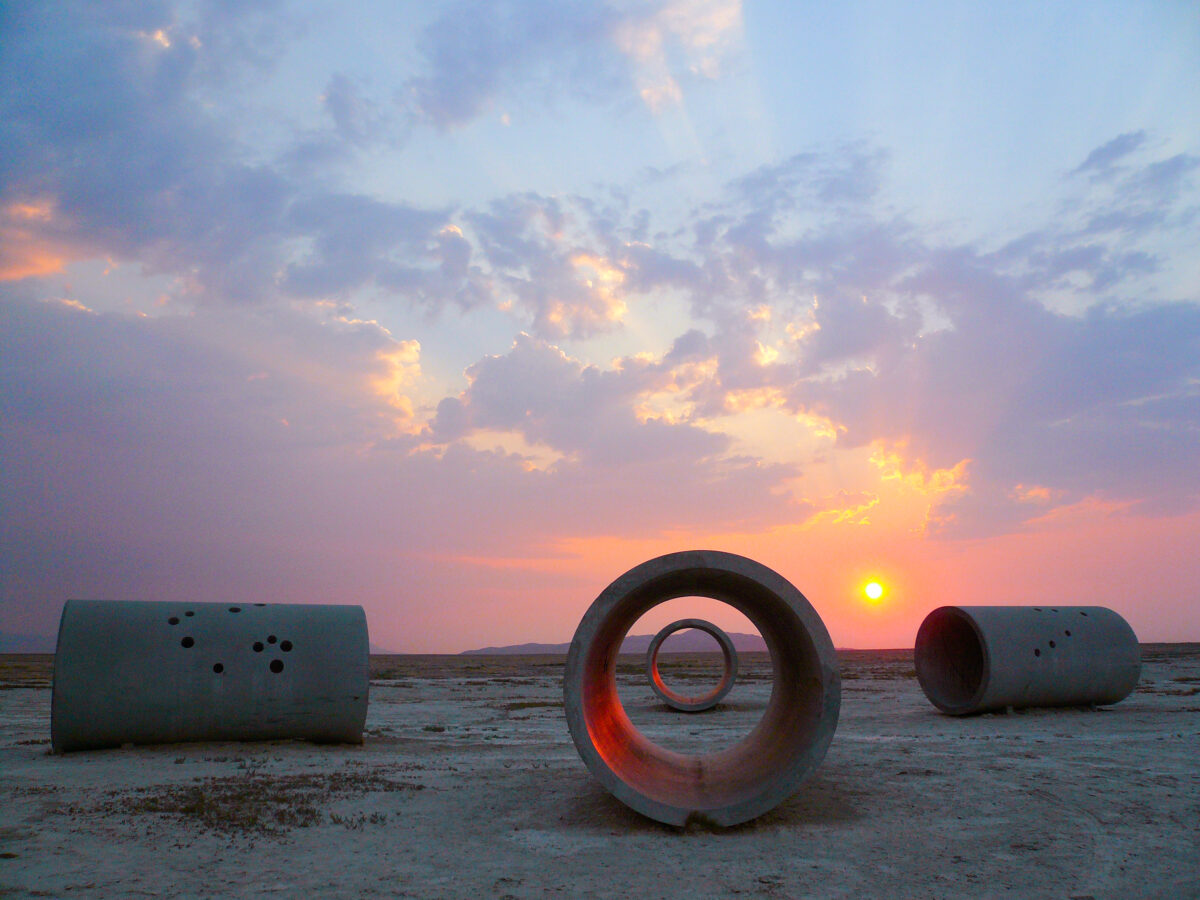
This project is a collaboration between HCN and The Nevada Independent. Additional reporting by Joey Lovato.
Editor’s Note: Alex Bybee is a board member of The Nevada Independent.

